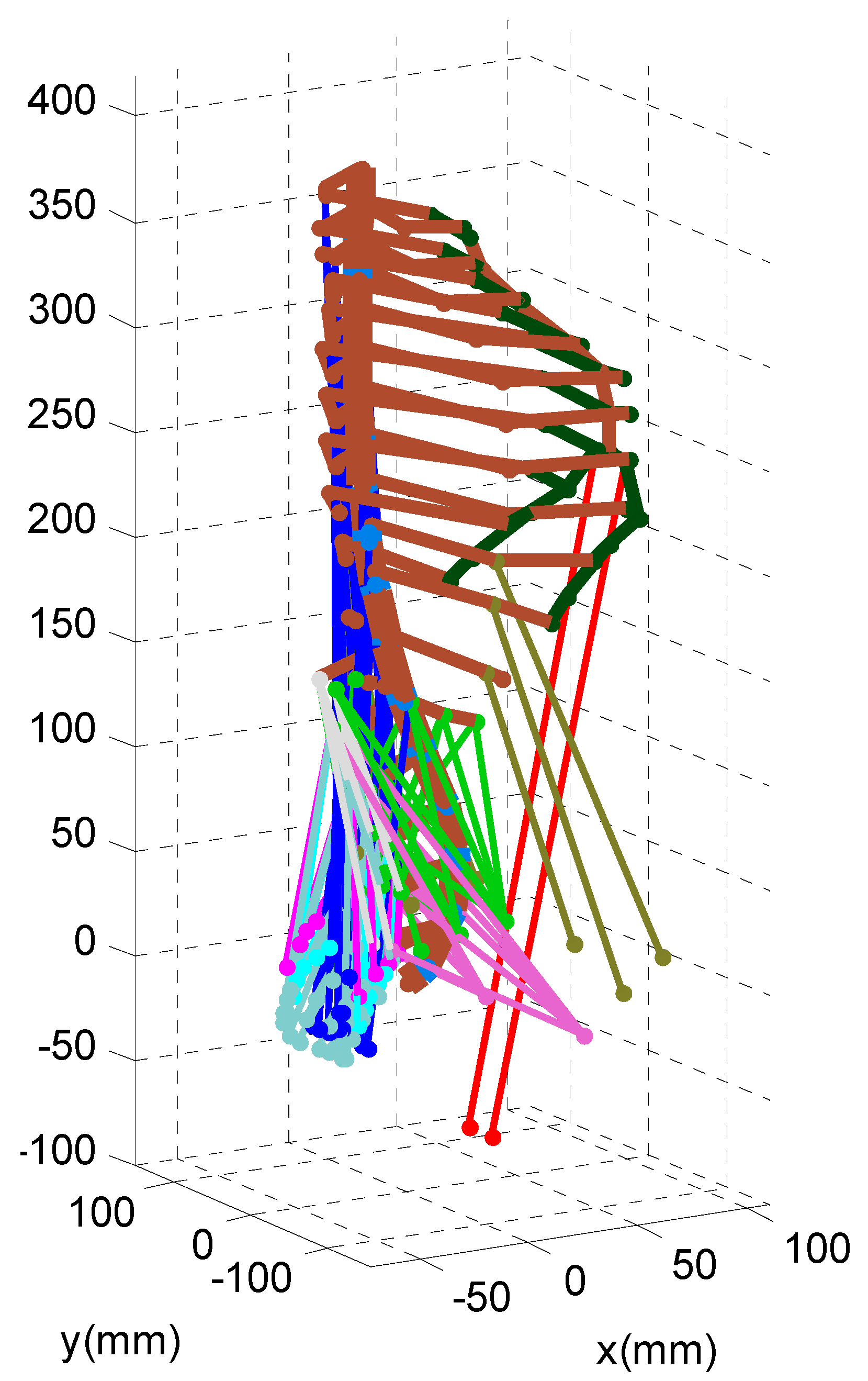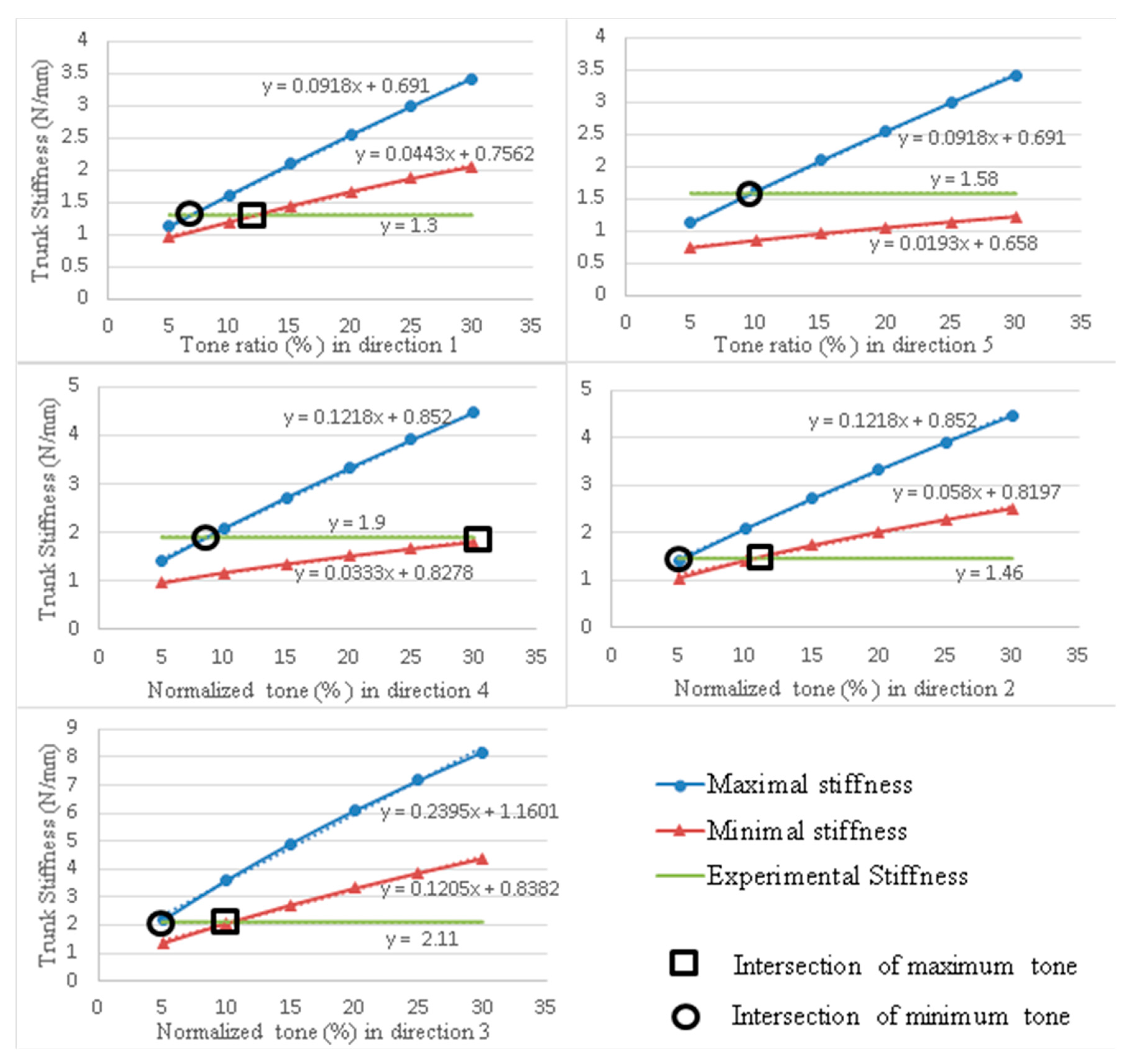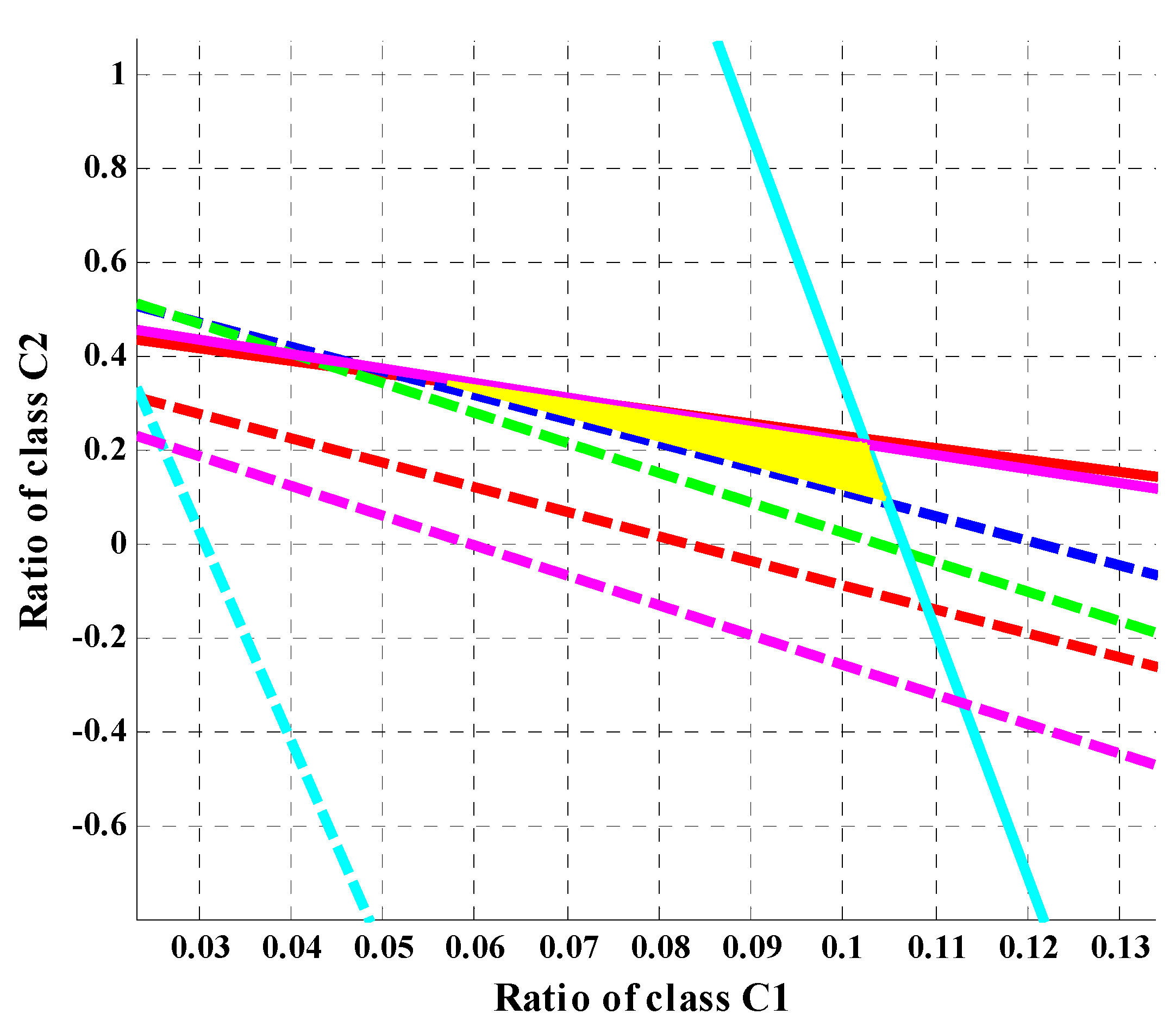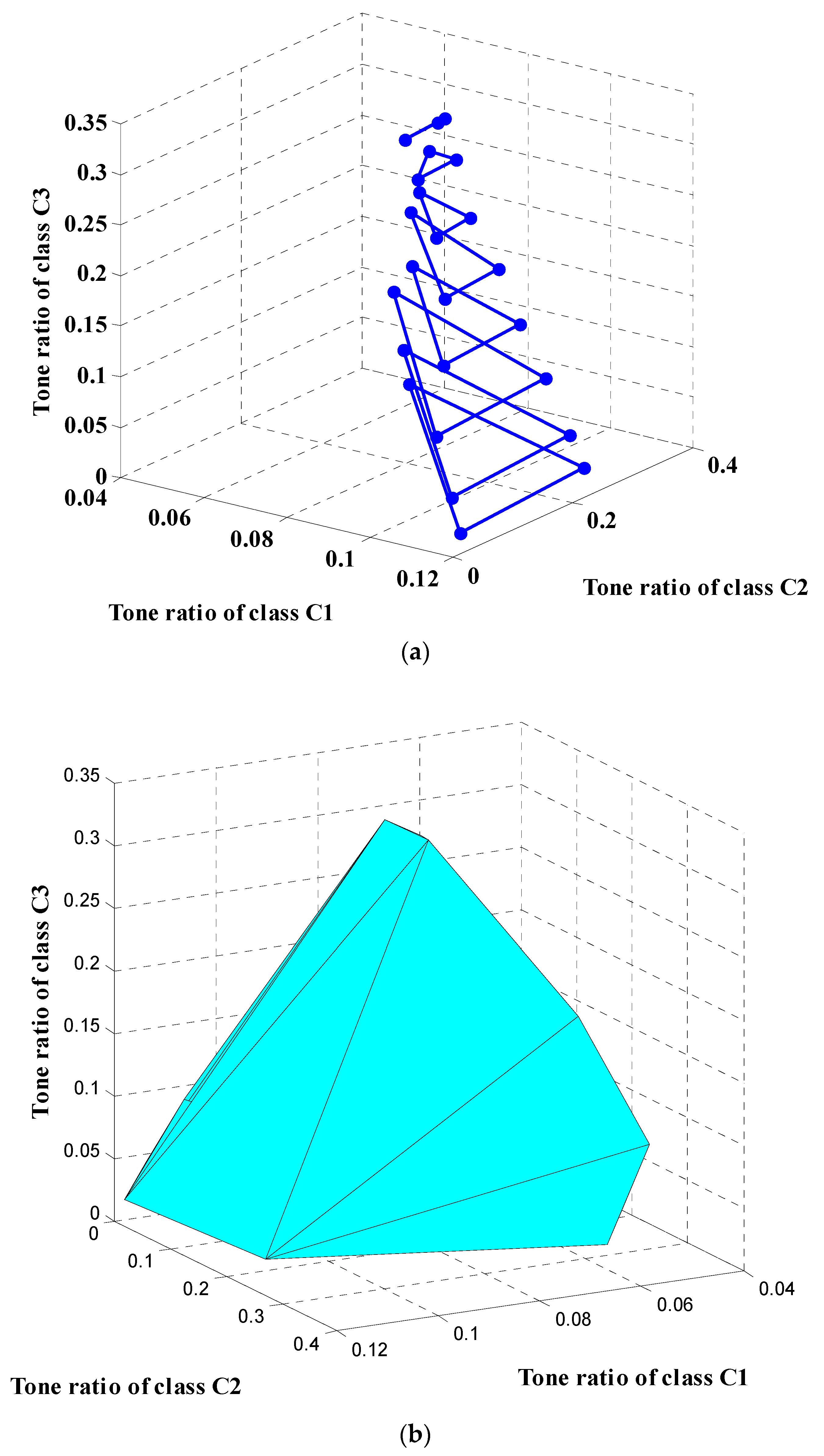Numerical Identification of Deep Muscle Residual Tensions (Tones) Based on Multi-Directional Trunk Stiffness Data
Abstract
:Featured Application
Abstract
1. Introduction
2. Materials and Methods
2.1. Experimental Trunk Stiffness
2.2. Trunk Numerical Model
2.3. Lower and Upper Stiffness Estimates
2.4. Tone Identification Problem Formulation
3. Results and Analysis
- Hypothesis of a Unique RMTT
- Hypothesis of Three Distinct RMTTs
3.1. Shortened Muscles
3.2. Identified Domain of Tone Ratios
3.2.1. Case of Unique Tone Ratio
3.2.2. Case of Three-Tone Ratios
4. Discussion
5. Conclusions
Author Contributions
Funding
Acknowledgments
Conflicts of Interest
Appendix A
| Muscle (Group) | Direction of Position Perturbation | ||||||||||||
|---|---|---|---|---|---|---|---|---|---|---|---|---|---|
| # | Class | Label | Number of Muscles | 1 | 2 | 3 | 4 | 5 | |||||
| R | L | R | L | R | L | R | L | R | L | ||||
| 1 | C1 | RA | 2 | (1) | (1) | (1) | (1) | - | 1 | - | - | - | - |
| 2 | C3 | PM | 22 | (11) | (11) | - | 11 | - | 11 | - | 11 | - | - |
| 3 | QL | 36 | (2) | (2) | - | 15 | - | 18 | (6) | (6) + 11 | - | - | |
| 4 | C1 | EO | 6 | (3) | (3) | - | 3 | - | 3 | - | 2 | - | - |
| 5 | LT | 24 | - | - | - | - | - | 9 | (9) | (9) + 1 | (10) | (10) | |
| 6 | Ilpt | 16 | - | - | - | 2 | - | 8 | (8) | (8) | (8) | (8) | |
| 7 | Ltpl | 10 | - | - | - | - | - | 5 | (5) | (5) | (5) | (5) | |
| 8 | Ilpl | 8 | - | - | - | 1 | - | 4 | - | - | (4) | (4) | |
| 9 | C2 | TM | 10 | - | - | - | - | - | 3 | - | - | (5) | (5) |
| 10 | M | 40 | - | - | - | - | - | 20 | (20) | (20) | (20) | (20) | |
| Total | 174 | 17 | 17 | 1 | 33 | 0 | 82 | 48 | 73 | 52 | 52 | ||
| Muscle Class | Identified RMTT Range (%) | Muscle Groups | Reference RMTT Range/(Overlap) | |||
|---|---|---|---|---|---|---|
| McGrill 1991 | Park 2014 | Kiesel 2007 | Lee 2011 * | |||
| C1 | 5–12 | RA | 2–5 (5) | - | - | - |
| EO | 4–6 (4–6) | 9–12 (9–12) | - | - | ||
| LT-Ilpt | 2–21 (5–12) | 8–14 (8–12) | - | 18–20 * (No overlap) | ||
| Ltpl/-Ilpl | 4–7 (5–7) | - | - | - | ||
| C2 | 6–33 | TM | - | - | - | 19–32 * (19–32) |
| M | - | - | 9 (9) | - | ||
| C3 | 2–33.5 | PM | - | 4–8 (4–8) | - | - |
| QL | - | 2–5 (2–5) | - | - | ||
References
- Gurfinkel, V.; Cacciatore, T.W.; Cordo, P.; Horak, F.; Nutt, J.; Skoss, R. Postural muscle tone in the body axis of healthy humans. J. Neurophysiol. 2006, 96, 2678–2687. [Google Scholar] [CrossRef] [PubMed]
- Mehrez, S.; Smaoui, H.; Ben Salah, F.Z. A biomechanical model to simulate the effect of a high vertical loading on trunk flexural stiffness. Comput. Methods Biomech. Biomed. Eng. 2014, 17, 1032–1041. [Google Scholar] [CrossRef]
- Lang, C. Impaired motor control. In Geriatric Physical Therapy; Elsevier Inc.: Amsterdam, The Netherlands, 2012; pp. 272–291. [Google Scholar] [CrossRef]
- Huang, H.W.; Ju, M.S.; Lin, C.C. Flexor and extensor muscle tone evaluated using the quantitative pendulum test in stroke and parkinsonian patients. J. Clin. Neurosci. 2016, 27, 48–52. [Google Scholar] [CrossRef]
- Franzén, E.; Paquette, C.; Gurfinkel, V.S.; Cordo, P.J.; Nutt, J.G.; Horak, F.B. Reduced performance in balance, walking and turning tasks is associated with increased neck tone in Parkinson’s disease. Exp. Neurol. 2009, 219, 430–438. [Google Scholar] [CrossRef] [PubMed] [Green Version]
- Rusu, L.; Cosma, G.; Calina, M.L.; Dragomir, M.M.; Marin, M. Evaluation of two muscle training programs by assessment of the muscle tone. Sci. Sport. 2015, 30, e65–e72. [Google Scholar] [CrossRef]
- Aird, L.; Samuel, D.; Stokes, M. Quadriceps muscle tone, elasticity and stiffness in older males: Reliability and symmetry using the MyotonPRO. Arch. Gerontol. Geriatr. 2012, 55, e31–e39. [Google Scholar] [CrossRef] [PubMed]
- Kocur, P.; Grzeskowiak, M.; Wiernicka, M.; Goliwas, M.; Lewandowski, J.; Łochyński, D. Effects of aging on mechanical properties of sternocleidomastoid and trapezius muscles during transition from lying to sitting position-A cross-sectional study. Arch. Gerontol. Geriatr. 2017, 70, 14–18. [Google Scholar] [CrossRef] [PubMed]
- Agyapong-Badu, S.; Warner, M.; Samuel, D.; Stokes, M. Measurement of ageing effects on muscle tone and mechanical properties of rectus femoris and biceps brachii in healthy males and females using a novel hand-held myometric device. Arch. Gerontol. Geriatr. 2016, 62, 59–67. [Google Scholar] [CrossRef] [PubMed] [Green Version]
- Mehrez, S.; Smaoui, H. Directional Dependence of Experimental Trunk Stiffness: Role of Muscle-Stiffness Variation of Nonneural Origin. Appl. Bionics Biomech. 2020, 2020, 8837147. [Google Scholar] [CrossRef]
- Kimoto, A.; Yamada, Y. A new layered sensor for simultaneous measurement of EMG, MMG and oxygen consumption at the same position. Med. Biol. Eng. Comput. 2015, 53, 15–22. [Google Scholar] [CrossRef] [PubMed]
- Lee, L.J.; Coppieters, M.W.; Hodges, P.W. En bloc control of deep and superficial thoracic muscles in sagittal loading and unloading of the trunk. Gait Posture 2011, 33, 588–593. [Google Scholar] [CrossRef]
- Keijsers, J.M.T.; Leguy, C.A.D.; Narracott, A.J.; Rittweger, J.; van de Vosse, F.N.; Huberts, W. Modeling regulation of vascular tone following muscle contraction: Model development, validation and global sensitivity analysis. J. Comput. Sci. 2018, 24, 143–159. [Google Scholar] [CrossRef] [Green Version]
- Byrne, C.A.; Lyons, G.M.; Donnelly, A.E.; O’keeffe, D.T.; Hermens, H.; Nene, A. Rectus femoris surface myoelectric signal cross-talk during static contractions. J. Electromyogr. Kinesiol. 2005, 15, 564–575. [Google Scholar] [CrossRef] [PubMed]
- Kilner, J.M.; Baker, S.N.; Lemon, R.N. A novel algorithm to remove electrical cross-talk between surface EMG recordings and its application to the measurement of short-term synchronisation in humans. J. Physiol. 2002, 538, 919–930. [Google Scholar] [CrossRef] [PubMed]
- Pomeroy, V.M.; Dean, D.; Sykes, L.; Faragher, E.B.; Yates, M.; Tyrrell, P.J.; Moss, S.; Tallis, R.C. The unreliability of clinical measures of muscle tone: Implications for stroke therapy. Age Ageing 2000, 29, 229–233. [Google Scholar] [CrossRef] [PubMed] [Green Version]
- Viir, R.; Laiho, K.; Kramarenko, J.; Mikkelsson, M. Repeatability of trapezius muscle tone assessment by a myometric method. J. Mechan. Med. Biol. 2006, 6, 215–228. [Google Scholar] [CrossRef]
- Vette, A.H.; Masani, K.; Wu, N.; Popovic, M.R. Multidirectional quantification of trunk stiffness and damping during unloaded natural sitting. Med. Eng. Phys. 2014, 36, 102–109. [Google Scholar] [CrossRef] [PubMed]
- Moorhouse, K.M.; Granata, K.P. Trunk stiffness and dynamics during active extension exertions. J. Biomech. 2005, 38, 2000–2007. [Google Scholar] [CrossRef] [Green Version]
- Brown, S.H.; McGill, S.M. The relationship between trunk muscle activation and trunk stiffness: Examining a non-constant stiffness gain. Comput. Methods Biomech. Biomed. Eng. 2010, 13, 829–835. [Google Scholar] [CrossRef] [PubMed]
- Christophy, M.; Senan, N.A.F.; Lotz, J.C.; O’Reilly, O.M. A musculoskeletal model for the lumbar spine. Biomech. Model. Mechanobiol. 2012, 11, 19–34. [Google Scholar] [CrossRef] [Green Version]
- Moalla, F.; Mehrez, S.; Najar, F. Dynamic identification of human trunk behavior as a diagnosis tool for pathologic problems. In Proceedings of the IEEE 4th Middle East Conference on Biomedical Engineering (MECBME), Gammarth, Tunisia, 29–30 March 2018; pp. 51–55. [Google Scholar] [CrossRef]
- Zajac, F.E. Muscle and tendon: Properties, models, scaling, and application to biomechanics and motor control. Crit. Rev. Biomed. Eng. 1989, 17, 359–411. [Google Scholar] [PubMed]
- Bergmark, A. Stability of the lumbar spine: A study in mechanical engineering. Acta Orthop. Scand. 1989, 60 (Suppl. 230), 1–54. [Google Scholar] [CrossRef] [PubMed]
- Ntousis, T.; Mandalidis, D.; Chronopoulos, E.; Athanasopoulos, S. EMG activation of trunk and upper limb muscles following experimentally-induced overpronation and oversupination of the feet in quiet standing. Gait Posture 2013, 37, 190–194. [Google Scholar] [CrossRef] [PubMed]
- McGill, S.M. Electromyographic activity of the abdominal and low back musculature during the generation of isometric and dynamic axial trunk torque: Implications for lumbar mechanics. J. Orthop. Res. 1991, 9, 91–103. [Google Scholar] [CrossRef]
- Park, R.J.; Tsao, H.; Cresswell, A.G.; Hodges, P.W. Anticipatory postural activity of the deep trunk muscles differs between anatomical regions based on their mechanical advantage. Neuroscience 2014, 261, 161–172. [Google Scholar] [CrossRef]
- Kiesel, K.B.; Uhl, T.L.; Underwood, F.B.; Rodd, D.W.; Nitz, A.J. Measurement of lumbar multifidus muscle contraction with rehabilitative ultrasound imaging. Man. Ther. 2007, 12, 161–166. [Google Scholar] [CrossRef]







| Direction # | 1 | 2 | 3 | 4 | 5 |
|---|---|---|---|---|---|
| Trunk stiffness (N/mm) | 1.30 | 1.46 | 2.11 | 1.90 | 1.58 |
| Classes | Muscles |
|---|---|
| C1 | RA—(2)/EO—(6)/LT—(24)/Ilpt—(16)/Ltpl—(10)/Ilpl—(8) |
| C2 | TM—(10)/M—(40) |
| C3 | PM—(22)/QL—(36) |
| Direction # | RMTTs (%) | |
|---|---|---|
| βmin | βmax | |
| 1 | 6.7 | 11.9 |
| 2 | 5.4 | 10.8 |
| 3 | 4.8 | 10.2 |
| 4 | 8.6 | 31 |
| 5 | 9.6 | 48 |
Publisher’s Note: MDPI stays neutral with regard to jurisdictional claims in published maps and institutional affiliations. |
© 2022 by the authors. Licensee MDPI, Basel, Switzerland. This article is an open access article distributed under the terms and conditions of the Creative Commons Attribution (CC BY) license (https://creativecommons.org/licenses/by/4.0/).
Share and Cite
Smaoui, H.; Mehrez, S.; Omri, M. Numerical Identification of Deep Muscle Residual Tensions (Tones) Based on Multi-Directional Trunk Stiffness Data. Appl. Sci. 2022, 12, 11802. https://doi.org/10.3390/app122211802
Smaoui H, Mehrez S, Omri M. Numerical Identification of Deep Muscle Residual Tensions (Tones) Based on Multi-Directional Trunk Stiffness Data. Applied Sciences. 2022; 12(22):11802. https://doi.org/10.3390/app122211802
Chicago/Turabian StyleSmaoui, Hichem, Sadok Mehrez, and Mohamed Omri. 2022. "Numerical Identification of Deep Muscle Residual Tensions (Tones) Based on Multi-Directional Trunk Stiffness Data" Applied Sciences 12, no. 22: 11802. https://doi.org/10.3390/app122211802
APA StyleSmaoui, H., Mehrez, S., & Omri, M. (2022). Numerical Identification of Deep Muscle Residual Tensions (Tones) Based on Multi-Directional Trunk Stiffness Data. Applied Sciences, 12(22), 11802. https://doi.org/10.3390/app122211802






